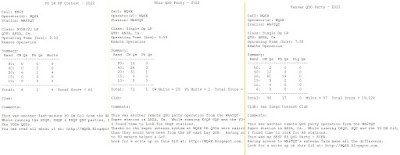I have often said I am a knob-twiddler - I love having the ability to tweak receive signals, making
them even more readable. Using a transceiver like the Yaesu FT-2000 allows me to largely do just that. However, most of the signal-adjustment (NB, NR, Shift/Width and Contour) are all accomplished in the I-F (Intermediate Frequency) stages. It is at the A-F (audio) end of the signal line where peaking and Stereo-Cw actually happen.
Over the years, I have used many external audio processing units such as the MFJ-752's
(For signal enhancement) and the Autek QF-1A's for creating Stereo-Cw. Those devices utilize
early-80's era analog IC technology. As we moved into the 90's, the technology evolved into
Digital Signal Processing (DSP). In the late 80's, Kenwood introduced their IF-based DSP-100,
an interesting idea that was way over-priced and really not very impressive. Altho it DiD work reasonably well with transmit audio, being an external box, it was (in my mind) to clunky to
really be useful.

Radio Shaft introduced what they called the Realistic DSP-40. Having opened the DSP-40 for an electronics inspection, I haven't a clue what it REALLY does, however, the fact that it produces low
distortion amplified audio, makes it marginally useful. As I
introduce the WQ6X audio-processing panel in up-coming months, I will
make way for inclusion of the DSP-40 in that configuration, offering an
empirically more-objective evaluation of this 30-year-old "DSP"
technology.
It would seem that the DSP-40 unit operates more like an analog-based device. While it employs a D16041FN microprocessor, that alone does not make the DSP-40 an actual DSP device. Looking at the block diagram, no mention is made of any A-D (analog-to-digital) or D-A (digital-to-analog) signal processing.
The 90's brought us two major DSP manufacturers: Timewave and JPS communications.
MFJ joined in with 2 models of the MFJ-784 DSP unit (unique in that it was "programmable").
While an older MFJ-784 has been added to the left-channel audio in the current WQ6X audio-configuration, I found little value in the less-expensive Timewave units. Altho the high-end DSP-599zx is quite capable, (in my opinion) it is way over-priced. Even today, those units (when they
can be found) price-out at around $400 (more than the original price).
The JPS NIR-10 & NIR-12 are just as capable, more readily attainable and can easily be had
for under $150. My only concern with these devices is that they run those 40-mhz TI DSP-chips intensely, generating an immense amount of heat. The MFJ-784 units run rather cool; but then
the enclosures for the MFJ units are more-or-less double the physical-size of the JPS boxes and therefore twice-as-much cooler.
Because the JPS units are designed to handle a number of different signal conditions, a 130ms delay occurs from signal-in to signal-out due to slow processing speed (compared to today's DSP chips) of the older TI DSP-chips. Normally this is not an issue. However, with Stereo-Cw often the [more-or-less] same signal appears in both ears [more-or-less] simultaneously, the 130ms processing delay often results in a sort of Left-Right ECHO (echo) which can be very confusing and/or annoying. While we can't speed up the DSP chips, we CAN introduce a delay into the unprocessed ear audio.
To accomplish the necessary Milli-second delay an AP-411 (Lip Sync
Corrector) has been added to the left-channel audio line, allowing an
adjustable delay from 0 to ~400 milliseconds to balance out the audio
response. While these units are not cheap ($189 new), a used one was
found on eBay for $74.99 that has operated flawlessly. While the
adjustment knob is tiny and a bit clumsy, it usually needs be set once
for an entire contest weekend, altho sometimes there is a noticeable
difference when switching from Cw to Ssb (in a multi-mode contest).
Knife and Rotary switches can contribute to the feeling of selecting different units or unit combinations.
For easier interpretation, each individual unit should have a letter designation. Example: A) QF-1A, B) QF-1A,
C) NIR-10, D) NIR-12, E) MFJ-752B,
F) MFT-752C, G) MFJ-784, H) DSP-40, I) MFJ-721.
In addition to rotary switches, we can make use of a logic-selected relays (similar to ATU antenna tuning units
built-in to most modern transceivers).
As mentioned earlier, intermixing a number of different audio units (with shared and different power sources) risks creating an unintended ground-loop throughout the audio lines. These loops can be mitigated somewhat with grounding straps and bypass capacitors. While use of a stereo equalizer at the end of the audio line can tune out any remaining artifact, ideally it should not be generated at all.
There have been hundreds of different equalizers made in the last 40+ years, however my favorite unit is a quite inexpensive Radio Shack unit which sold originally for around $50 - WoW!
As you can see, I LOVE playing around with audio processing devices.
Each unit can take the amateur radio listening experience to the next level.
What about YOU?
Do YOU make use of audio processing?
What configurations are YOUR favorite?









.Jpg)



.Jpg)
.Jpg)












